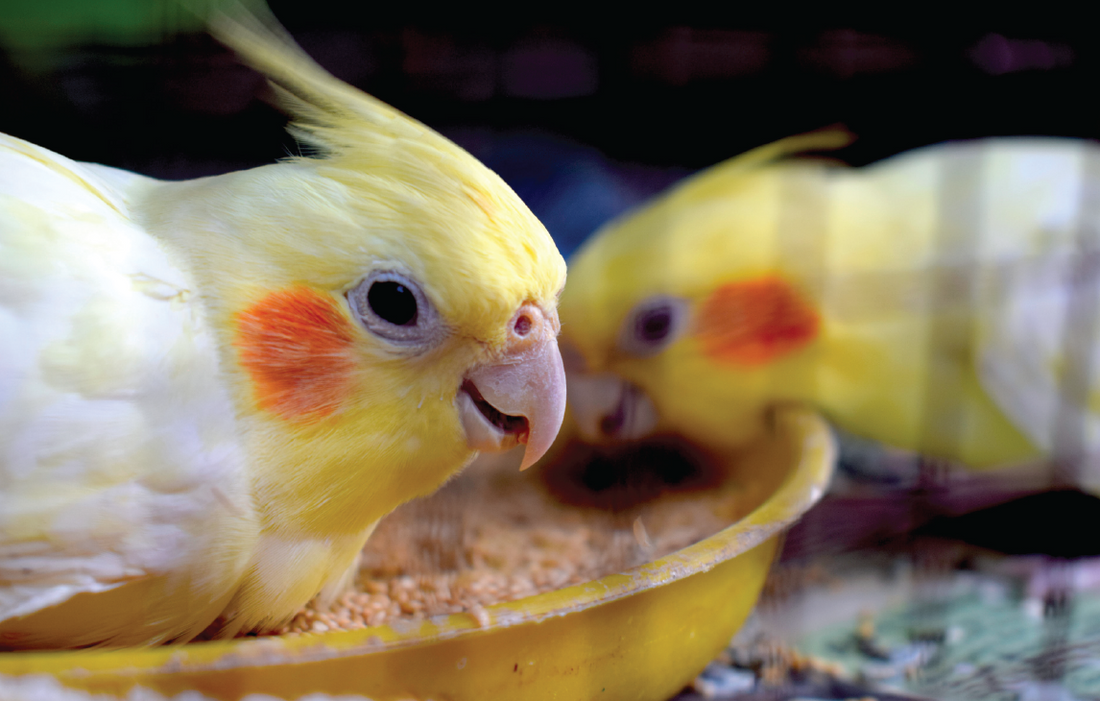
Birds in captivity suffer from two major issues. First, they do not get to exercise or forage for food in any way similar to their wild counterparts. Secondly, we have provided a diet that is calorically dense and nutrient poor which does not meet the essential micronutrients. As a result, birds eat to satisfy the energy requirements and captive birds would consume lower amounts of energy and therefore not meet the micro nutrient demands. Diets for captive birds should be lower in energy to stimulate appetite and higher in trace elements to take into account the lower ingested levels and greater needs.
Commonly diets based on seeds leads to birds suffering from obesity and they are often nutrient deficient. So why not just add mineral or vitamin supplements?
Dietary correction should not be a “top – up” of any perceived deficiencies. These deficiencies can be difficult for even seasoned professionals to diagnose and just sprinkling a powder on a large bowl of seeds would have less than satisfactory results. Water supplementation is equally fraught with issues. Aqueous minerals and vitamins are prone to spoilage and with water consumption being variable, intake can be a problem. As well excessive intake of these supplements can lead to hypervitaminosis such as with vitamin A and D.
With these points in mind, it should be noted that formulated diets play an integral role in feeding all types of animals from pets to farming. Due to the problem of achieving a balanced diet through the mixing of various foods most veterinarians would choose to feed a formulated pellet. The aim is to follow the natural foods of the species to be fed and using a general matrix and analysis of feed stuffs and supplements, they are added to provide essential nutrients relative to the dietary intake. In this way for our captive birds, energy levels can be kept low to ensure the bird eats a correct amount to ingest the needed micronutrients to remain healthy.
Weaning a bird a bird onto a pellet diet has been known to be difficult but before we address some strategies on how to do just that, it should be noted that there is never a cause to starve a bird into submission of a new diet.
Dietary habits are learned at an early stage in life and changes require a re-education and this can take a period of time. So don’t get discouraged and find the right people to support you


Pictured above: Harrison's high potency coarse pellets and adult lifetime fine pellets
Let’s start with some things we need to measure.
- Regular weights should be taken during the conversion process. Small birds should be weighed daily and larger birds 2 to 3 times a week. In the first week a small bird should not lose more than 5% of its body weight and larger birds not more than 10%. If this does happen the conversion process should be stopped until the bird is stabilised.
- It will pay to monitor the amount of food and water given daily and to measure the amount of droppings produced. This will give you a good indicator if things are progressing or not.
Strategies:
- Use a converted bird as a role model. If there is already a converted bird in the household, it can be used as a “trainer” bird to model the feeding behaviour. You can place it near or even if possible with the bird trying to be converted.
- Reduce food availability for 7 to 10 days prior to conversion. Limit the normal food that is provided to encourage it to eat what is available and only provide additional food once all of it is eaten. Keep water bowls very clean and add a soluble mineral/vitamin mix to help stimulate appetite.
- Weaning off the old diet. Offer a very small amount of the usual food in the normal bowl and remove once eaten or after a short while. Replace the usual food with the new pellet in the same bowl and place it in the cage in the same place. The new pellets should be available for the remainder of the day. If eaten it should be topped up with pellets. In the evening the pellets are removed a small amount of fruit/veg and small amount of usual food are replaced and then removed if eaten or in the cage for a short time. Gradually reduce the amount of the usual diet once the pellets are being eaten regularly.
- Enhance the new diet. Heating the pellets slightly and/or adding things like fruit juice, whole fruit or veggies can be used to encourage the bird to taste the new food and stimulate it to accept it. Crumbling pellets onto fruit or veggies is also a good way to encourage them to accept the new taste.
- Hand feeding or pretending to eat the pellets yourself is also a good way to stimulate them to try a new food.
- Changing a birds environment can work. A novel environment can challenge them to accept a new normal.
- Finding the right pellet is crucial. There are several option available on the market. sometimes it's a case of finding the pellets that's the most appetising to your bird. Switching to healthier pellet will come a lot easier once they are initially converted by a tastier pellet
Veterinary supervision is often needed to make sure your bird doesn’t compromise its health. Regular monitoring can be necessary. All these strategies require a thought out process prior to implementing but the conversation to pellets can provide birds in captivity with a foundation to build a happy and healthy life.

